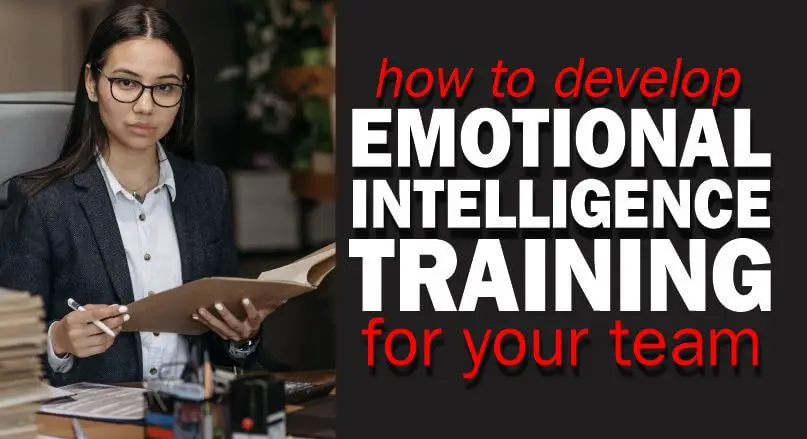Last updated on April 25th, 2025 at 02:54 am
Learn how to develop emotional intelligence training for your team through diverse methods and personalized approaches for a productive work environment.
Employees need excellent workplace ethics, including good communication skills, for a productive environment.
Without training, toxicity and indiscipline can prevail.
As a social psychologist, I’ve outlined a comprehensive training procedure to promote healthy coexistence and enhance performance, suitable for organizations of any size.
While this guide may seem ambiguous to newcomers in emotional intelligence, careful examination of the procedures will make it easier to understand.
Table of Contents
- Overview of Emotional Intelligence
- What is Emotional Intelligence Training?
- Emotional Intelligence Training for Leaders
- Emotional Intelligence Training for Employees
- Emotional Intelligence Training for Managers
- Emotional Intelligence Training in The Workplace
- Benefits of EQ Training for Your Team
- Assessing Your Team’s Current EQ Before Training
- Develop an Emotional Intelligence Training Program
- Frequently Asked Questions
- Final Thoughts
Overview of Emotional Intelligence
Before initiating emotional intelligence training, it is crucial to develop a thorough understanding of the concept.
Emotional intelligence comprises five key components: self-awareness, self-regulation, motivation, empathy, and social skills.
Encourage team members to assess their current EI levels by utilizing assessment tools like the Mayer-Salovey-Caruso Emotional Intelligence Test (MSCEIT).
This initial evaluation will provide a baseline for designing customized training interventions.
What is Emotional Intelligence Training?

Emotional intelligence (EI) training in the workplace is a program designed to help employees develop social awareness and other skills to recognize, understand, and manage their own emotions, as well as the emotions of others, in a work context.
The goal of EI training is to help employees improve their ability to communicate effectively, build strong relationships with colleagues and customers, and make better decisions in their work.
EI training in the workplace typically involves a series of activities and exercises designed to help employees develop specific skills, such as self-awareness, self-regulation, empathy, and social skills.
These activities may include self-reflection exercises, role-playing scenarios, group discussions, and case studies that are tailored to the specific needs of the organization and its employees.
Emotional intelligence training for employees is made up of the following domains of development:
- Self-awareness
- Self-management
- Social awareness
- Relationship management
Emotional Intelligence Training for Leaders
Emotional intelligence training for leaders can be delivered through various methods such as workshops, coaching sessions, role plays, and feedback exercises.
It typically involves a combination of theoretical knowledge, experiential learning, and practical application in real-world scenarios.
The benefits of emotional intelligence training for leaders include improved decision-making, better teamwork and collaboration, increased employee engagement, enhanced conflict resolution skills, and overall improved leadership effectiveness.
By developing their emotional intelligence, leaders can create a positive work environment, promote trust and loyalty among their team members, and drive better organizational outcomes.
Emotional Intelligence Training for Employees
Emotional intelligence training for employees focuses on equipping them with skills to understand and manage emotions effectively.
It helps employees enhance self-awareness, regulate emotions, and develop empathy and social skills.
This training enables employees to navigate conflicts, build productive relationships, and enhance overall job satisfaction and performance.
Emotional Intelligence Training for Managers
EQ for managers is targeted at enhancing their leadership skills and ability to manage and motivate teams effectively.
It includes understanding and managing their own emotions, as well as developing empathy and social skills to foster better communication and collaboration.
This training also equips managers with the skills to resolve conflicts, provide constructive feedback, and create a positive work environment.
Emotional Intelligence Training in The Workplace
EQ training in the workplace aims to foster a culture of emotional intelligence throughout the organization.
It involves training all employees, from entry-level to executives, to develop emotional awareness, empathy, and effective communication skills.
By integrating emotional intelligence into the workplace, organizations can improve teamwork, enhance employee engagement, reduce conflicts, and promote a healthy and supportive work environment.
This training can lead to increased productivity, better decision-making, and improved overall organizational success.
Benefits of EQ Training for Your Team
Emotional intelligence training can help team members to better understand and manage their emotions, leading to stronger relationships, improved communication, and higher job satisfaction
Emotional intelligence (EI) training can have numerous benefits for your team. Here are they:
Good Communication Skills: Emotional intelligence training helps individuals develop the skills for effective communication.
Improved Communication: Enhances understanding and expression of emotions, leading to improved communication and stronger relationships.
Better Conflict Resolution: Equips team members to manage conflicts constructively through increased emotional understanding.
Increased Empathy: Develops empathy, promoting better collaboration and teamwork.
Higher Job Satisfaction: Strong emotional intelligence skills lead to better stress management and positive relationships, resulting in higher job satisfaction.
Improved Leadership: Strong emotional intelligence in leaders creates a positive work environment and increases productivity.
Improved Self-awareness: Emotional intelligence training enhances understanding of one’s emotions, motivations, and behaviors.
Improved Social Awareness: Develops the ability to understand and empathize with others’ emotions, needs, and perspectives.
Teamwork and Collaboration: Enhances empathy, communication, conflict resolution, and stress management for improved teamwork.
Stress Management: Improves self-awareness, self-regulation, and resilience for effective stress management.
Assessing Your Team’s Current EQ Before Training
Assessing your team’s emotional intelligence before training can help you tailor your emotional intelligence training to their specific needs and ensure that you address any gaps in their understanding.
Here are some ways to assess your team’s emotional intelligence:
1. Surveys
By using a survey to assess your team’s emotional intelligence before training, you can gain valuable insights into their strengths and weaknesses and ensure that your training is targeted and effective.
To assess emotional intelligence, you can design a survey that includes specific questions related to various aspects of emotional intelligence.
Here are some key areas to consider:
Self-awareness: Ask questions to gauge their ability to recognize and understand their emotions. For example, you can ask how well they recognize their emotions in different situations or if they can identify the triggers that lead to certain emotions.
Self-regulation: Evaluate their capability to manage and regulate their emotions. You can inquire about their coping mechanisms for stress or their ability to stay calm in challenging situations.
Empathy: Assess their capacity to understand and empathize with others’ emotions. Include questions that ask about their willingness to listen and support their teammates or their ability to pick up on nonverbal cues indicating someone’s emotional state.
Social Skills: Determine their interpersonal skills and ability to build strong relationships. Include questions about their teamwork approach, conflict resolution strategies, or their ability to communicate effectively with colleagues.
Motivation: Evaluate their level of motivation and passion towards work or team goals. You can ask about their ability to remain focused, persevere through setbacks, or their general level of enthusiasm.
The Design of the Survey

The survey should be designed using a Likert scale or multiple-choice format to easily analyze the responses quantitatively.
Additionally, consider including open-ended questions to gain deeper insights into their emotional intelligence.
After circulating the survey, collect and analyze the results. Identify the areas where your team excels or needs improvement in emotional intelligence.
This data will help you tailor your emotional intelligence training program to address the specific needs and challenges that your team faces.
With this assessment, you can determine the focus and content of the emotional intelligence training sessions.
It will ensure that the training is targeted and provides relevant skills to enhance your team’s emotional intelligence, thereby improving overall team dynamics, collaboration, and interpersonal relationships.
Related: Expert Power: Strategies For Building Credibility And Influence
2. Mayer-Salovey-Caruso Emotional Intelligence Test – Scales (MSCEIT)

This assessment measures EQ in the same way IQ does on cognitive intelligence. It examines the four branches of emotional intelligence:
- Emotion Perception: The capacity to perceive emotions in oneself and others as well as in objects, art, and music stories and respond to the stimuli around the environment.
- Facilitating Thought: This is the ability to generate, apply and feel the emotion as it is necessary to communicate feelings or apply them in other cognitive processes.
- Understanding Emotion: Understanding emotions is the ability to grasp the mechanics of emotions as they combine and progress through relationship transitions and how to appreciate their meanings.
- Emotion management: This is the ability to have an open mind for feelings to thrive, and then modulate them in oneself and in others to encourage and promote personal understanding and growth.
3. The Emotional Quotient Inventory (EQ-i)

The Emotional Quotient Inventory 2.0 (EQ-i 2.0) and the EQ-360 were formed to create the Bar-On model of emotional-social intelligence.
The EQ-i 2.0 is a measure of self-report designed to measure several constructs related to EI.
The EQ 360 assessment gives a better comprehensive analysis by asking the people who work with the candidate to provide information on the candidate as well.
Comparing observer ratings, with the results of an EQ-i 2.0 self-report, a clearer detailed profile is obtained.
The two assessments gauge emotional intelligence using one final score, five composite scores, and 15 specific subscale scores. Item-level results are also presented.
4. Emotional and Social Competence Inventory ESCI
Social intelligence makes the difference between a good intelligent leader who drives performance and growth and the average leader who gets by.
The real importance is derived from the 360-degree view of the pillar behaviours that stand outstanding leaders out from average performers.
It also helps to create a competitive advantage for professionals and managers for their company by upping performance, teamwork, innovation, and cohesion, and making sure resources and time are managed properly while building a culture of motivation and trust.
Use the emotional and social competency inventory (ESCI) to:
- Measure emotional intelligence in your leaders and professionals
- Initiate awareness through powerful feedback
- Concentrate your coaching and development on abilities
- Elicits the best in individuals and teams.
5. The Genos Emotional Intelligence Inventory (Genos EI)
The Genos Emotional Intelligence Inventory (Genos EI) is a behaviour-based test that measures an employee’s display of emotionally intelligent behaviour.
It provides a comprehensive insight into an individual’s workplace behaviour, based on feedback from those who observe the candidate regularly.
The test is supported by peer-reviewed research and is available in various formats and languages, used by many Fortune 500 companies.
Results are presented in detailed reports, internally benchmarked, and compared against global norms.
The test includes free text responses for each competency assessed and offers development tips to improve emotional intelligence.
It can be completed online on various devices and typically takes about 12 minutes.
The secure administration platform allows for easy setup, monitoring, and report downloading.
While not mandatory, administering the test can provide valuable insights into employees’ emotional intelligence, with the potential for improvement over time.
6. Feedback

It’s important to note that feedback can be both positive and negative. Use both types of feedback to celebrate successes and identify areas for improvement.
By using feedback to assess your team’s emotional intelligence before training, you can gain valuable insights into their strengths and weaknesses and ensure that your training is targeted and effective.
Here are some steps you can follow to gather feedback:
Identify the Right Feedback Providers: Select individuals who have closely worked with your team members and can offer an unbiased assessment of their emotional intelligence, such as supervisors, peers, or customers.
Develop a Feedback Survey: Create a survey with specific questions about your team members’ emotional intelligence, such as how they handle stress or communicate with others.
Administer the Survey: Distribute the survey to feedback providers, ensuring they have ample time to complete it. Consider making the survey anonymous to encourage honest responses.
Analyze the Results: After collecting the feedback, analyze the data to identify patterns and trends, pinpointing areas where team members may need more training or support.
Use the Results to Inform Training: Tailor your training based on the feedback to address the specific needs of your team members. For instance, if a team member struggles with communication, focus the training on effective communication skills.
7. Focus Groups

Define the Purpose of the Focus Group: Identify the specific aspects of emotional intelligence to explore and the desired information to gather.
Identify the Participants: Select a diverse group with varied experiences and perspectives, including individuals from different departments, seniority levels, and demographics.
Develop a Discussion Guide: Create questions about emotional management, response to others’ emotions, and communication and collaboration.
Conduct the Focus Group: Facilitate the discussion using the guide, encouraging participants to share experiences and asking follow-up questions.
Analyze the Results: After the focus group, analyze the data to identify patterns and areas needing more training or support.
Use the Results to Inform Your Training: Tailor emotional intelligence training based on the focus group results, addressing specific needs such as stress management and emotional regulation techniques.
8. Self-assessment
Encourage team members to assess their emotional intelligence by completing a self-assessment questionnaire.
This can help them improve self-awareness by identifying their strengths and weaknesses in managing their emotions, as well as their understanding of others’ emotions.
9. Peer and Social Awareness Assessment
Ask team members to assess each other’s emotional intelligence. This can help team members gain insight into how they are perceived by others and identify areas for improvement.
10. Supervisor Assessment

Ask supervisors to assess their team members’ emotional intelligence.
Supervisors may have a better understanding of how their team members manage their emotions in the workplace and can provide feedback on areas for improvement.
11. 360-degree Assessment
This involves collecting feedback from multiple sources, including team members, supervisors, and peers.
This approach can provide a more comprehensive understanding of each team member’s emotional intelligence.
12. Observation
Observe your team members in action and assess how they manage their emotions in different situations.
This can provide valuable insights into their emotional intelligence and help you tailor your training to their specific needs.
Develop an Emotional Intelligence Training Program

Setting specific goals and objectives is crucial when developing an emotional intelligence (EI) training program for your team.
Clear goals and objectives help design a targeted and effective training program.
Here are steps to take in developing an emotional intelligence training for your team:
1. Set Specific Goals and Objectives
Setting specific goals and objectives is a crucial step when developing an emotional intelligence (EI) training program for your team.
Clear goals and objectives will help you design a targeted and effective training program that meets the needs of your team.
Here’s how to set specific goals and objectives:
Identify Areas for Improvement: Based on your team’s EI assessment, pinpoint specific areas for improvement such as self-awareness, self-regulation, empathy, social skills, or motivation.
Define Goals: Define specific, measurable, achievable, relevant, and time-bound (SMART) goals for the training program, such as improving emotional recognition and regulation in the workplace.
Break Goals into Objectives: Break down goals into concrete, actionable objectives, like teaching stress and anxiety management techniques.
Align Objectives with Training Methods: Consider the best training methods, such as classroom training, online modules, coaching sessions, or role-playing exercises, to achieve the objectives.
Set Timelines and Milestones: Establish timelines and milestones to track progress, including scheduling training sessions, tracking progress, and setting deadlines for completing objectives.
2. Determine the Training Format and Methods
The training format and methods for the emotional intelligence training of a team can vary based on the team’s size, goals, and available resources.
However, here are some general recommendations:
Training Format
- In-person training is highly effective for emotional intelligence training as it enables direct interaction between the trainer and team members. It can be conducted on-site or off-site based on availability and budget.
- Virtual training, conducted through video conferencing platforms, serves as a good alternative to in-person training, especially for remote or geographically dispersed teams.
Training Methods
Role-playing: Role-playing is an effective method for emotional intelligence training as it allows team members to practice communication and interpersonal skills in a safe environment.
Case Studies: Case studies enable analysis of real-life workplace situations, encouraging critical thinking and problem-solving.
Group Discussion: Group discussions encourage open sharing of thoughts and feelings, promoting empathy and understanding.
Mindfulness Exercises: Mindfulness exercises, including breathing and meditation, aid in developing self-awareness and emotion regulation.
Feedback Sessions: Feedback sessions facilitate constructive feedback exchange, enhancing communication skills and building trust within the team.
3. Decide on the Training Materials and Resources
Emotional intelligence (EI) training requires a variety of training materials and resources to be effective.
The materials and resources chosen should be engaging, relevant, and accessible to all team members.
Here are some recommendations for training materials and resources for EI training for your team:
Workbooks: Provide structured learning and practice through exercises, self-assessments, and case studies to develop EI skills.
Videos: Visualize and understand emotional concepts through expert interviews, real-life simulations, and training modules.
Books: Dive deeper into EI theory and research with resources like “Emotional Intelligence 2.0” by Travis Bradberry and Jean Greaves.
Online Courses: Offer convenient training with video lectures, interactive exercises, and quizzes for developing EI skills.
Assessments: Provide insights into strengths and weaknesses in areas like self-awareness, self-regulation, and social skills.
Coaching: Offer individualized support and guidance for identifying improvement areas and developing action plans.
A combination of these resources can effectively provide EI training. Choose engaging, relevant, and accessible materials to ensure effectiveness for all team members.
4. Develop a Training Schedule and Implementation Plan

Developing a training schedule and implementation plan for emotional intelligence training for your team can be broken down into the following steps:
Step 1: Assess Team Needs
As outlined at the beginning of this article, the first step is to determine the current emotional intelligence level of your team.
You can use assessments or surveys to gather data on areas of strengths and weaknesses, and then create a plan tailored to meet the needs of your team.
Step 2: Determine Objectives
After assessing your team’s needs, the next step is to determine what you want to achieve through the training.
This could include improving communication skills, conflict resolution, team building, and overall emotional intelligence.
Step 3: Create the Training Program
Using the data collected in step one and the objectives established in step two, develop a training program that will meet the specific needs of your team.
The training should be interactive and include activities and exercises to help participants learn and practice the skills they need.
Step 4: Choose the Delivery Method
The delivery method can include various options such as classroom sessions, online modules, webinars, coaching, and mentoring.
You may also consider a combination of these methods to meet the learning styles and preferences of your team members.
Step 5: Schedule the Training
The training program should be scheduled in a way that allows all team members to attend and participate. This could be done through a series of short sessions or a more extended program, depending on the complexity of the topics covered.
Step 6: Implementation and Feedback
Once the training program is implemented, gather feedback from team members to assess the effectiveness of the training.
This will help you identify areas of improvement for future training sessions and ensure that the training is meeting the objectives set in step two.
Frequently Asked Questions
What is emotional intelligence training?
It is a program that teaches employees how to recognize, understand, and manage their own emotions and the emotions of others. The goal of EI training is to improve communication, collaboration, and overall job performance.
How do you build emotional intelligence in a team?
Building emotional intelligence in a team involves fostering open communication, promoting empathy, and providing opportunities for self-reflection and feedback to enhance interpersonal understanding and collaboration.
How do you develop emotional intelligence training for employees?
Developing emotional intelligence training for employees entails identifying specific areas for improvement, creating tailored learning materials, and utilizing diverse methods such as role-playing and mindfulness exercises to enhance EI skills.
What are the ways to develop emotional intelligence?
Ways to develop emotional intelligence include utilizing resources like workbooks, videos, and assessments, incorporating diverse training methods, and providing individualized coaching and support for skill development.
How do you train leaders in emotional intelligence?
Training leaders in emotional intelligence involves personalized coaching, promoting self-awareness and empathy, and providing opportunities for leaders to practice effective communication and relationship management skills in various scenarios.
Final Thoughts
Developing emotional intelligence training for your team is a strategic investment in their personal and professional growth.
By incorporating diverse methods such as role-playing, case studies, and mindfulness exercises, you can cultivate essential skills like empathy, self-awareness, and effective communication.
Utilizing resources like workbooks, videos, and coaching further enriches the learning experience.
Tailoring the training to address specific needs and providing accessible, engaging materials ensures that your team can develop and apply emotional intelligence effectively in the workplace, fostering a more harmonious and productive environment.
REFERENCES
Training Others in Emotional Intelligence: Your Ultimate Guide
Emotional Intelligence Training
Emotional Intelligence Training: What Exactly Is It?
Assessing Emotional Intelligence Training
Emotional Intelligence Training Programs
Emotional Intelligence Training For Employees
Pyo Merez (PsyD) is a distinguished adolescent and adult psychologist at the forefront of mental health advocacy.
With expertise in cognitive and developmental psychology, focusing on social relationships, cultural contexts, and individual differences, Pyo has dedicated his career to empowering adolescents and adults.
As a sought-after speaker and panelist, Pyo shares invaluable insights on issues affecting young people, contributing to a deeper understanding of mental health and well-being in today's society.


